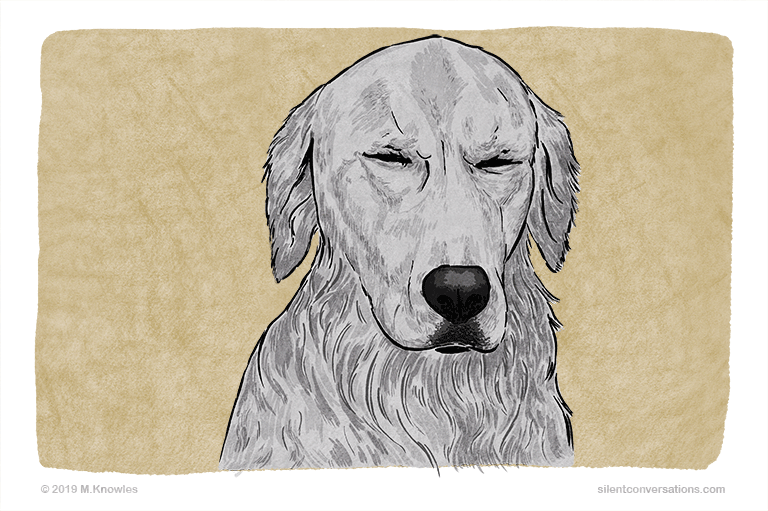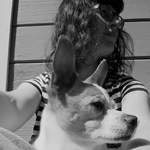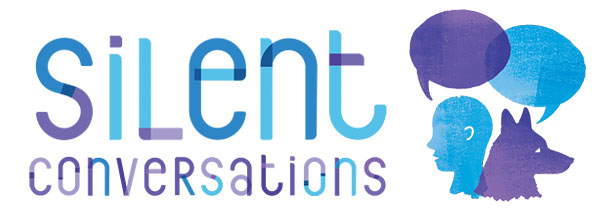
Eyes – Blinking – Dog Body Language
The dog body language signal of blinking the eyes relies very much on the context in which it occurs and the dog’s whole body language in order to be interpreted correctly. Generally, blinking can be seen as a calming signal and may be used as part of other body language to negotiate with another individual. At times, blinking can occur due to stress or fear. In other situations, it may be offered as appeasement. Depending on the combination of body language, it may also be offered to show good will, whilst trying to calm an interaction down.
Direct eye contact in dog body language is impolite; it is used to warn or can be interpreted as confrontational. The purpose of a direct stare is to create space and encourage the other party to move away. A warning may be shown with direct eye contact (known as a hard stare or hard eye). The eyes will most probably be quite round, wide, fixed and still, without any blinking. So blinking is the opposite of that. As staring is impolite in dog body language, a blink may be used as a strategy when giving selected short bursts of polite eye contact. The blinks that are used as part of communication may be exaggerated by using slow deliberate blinks, or they may occur frequently in quick succession.
Here are a few examples of situations where a dog may offer blinking:
- Two dogs are within close vicinity of one another in an open dog park. Suddenly, the one dog draws his attention towards the other dog. He does a three-quarter turn towards her and looks slightly tall, with his ears moving forwards and his tail up. He gazes over to the other dog and their eyes meet momentarily. Her reaction to the sudden eye contact is to turn her head marginally to the side, and, squinting her eyes slightly, she blinks a few times. He responds by blinking and turning his gaze away too. The other dog is trying to negotiate by blinking and turning her gaze away. She is saying she does not want to cause trouble and does not wish to interact.
- A dog that is sitting on the ground is being scolded by his guardian. The dog’s mouth is closed, and his ears are back and flat to his head. He turns his head to the side, then he turns it back to face his guardian and does a lip lick. His eyes are squinted when facing his guardian and he yawns. He continues to face his guardian with ears back and eyes squinted; then he displays a succession of quick eye blinks, followed by further lip licks and more eye blinks. This is the typical body language that is misinterpreted as the ‘guilty look’. The dog is showing appeasement with his body language; he is responding to his guardian’s aggressive sounding voice and body postures. By using appeasing body language, he is trying to calm the situation down and communicating to his guardian he means no harm. Here is some further reading explaining the guilty look and a study conducted by Alexandra Horowitz, proving ‘the look’ does not correspond with the dog’s knowledge of the ‘bad’ behaviour.
- This is an observation of a dog new to the shelter. She has only spent a couple of days in this unfamiliar environment and is fearful of the new surroundings and strangers at the shelter. A volunteer is trying to gain the dog’s trust and is sitting quietly across from her. The dog remains seated on the opposite side of the room and is keeping her distance from the person. The dog’s body is hunched over, with her head slightly down and her mouth closed. She seems very still, apart from occasionally turning her head slightly away from the person and giving a few blinks. On the previous occasion when the person spent time in the room, the dog’s eyes were wide and fixed on the person, and she displayed the same frozen looking body language. Although this dog is still frightened, the blinking is progress, as she is at least showing signs of communication and expressing herself. She is trying to communicate that she means no harm and does not want to be harmed. Taking into account the observations of the rest of her body language, it is apparent that the dog is still feeling fearful.
- A dog is sitting in front of her guardian, who is filming her. There seems to be no tension in the dog’s body as she sits. Her tail is wagging in circles low to the ground. Her mouth is closed with no tension in the face muscles. Her ears are pointy, and they are in a neutral position, held up but ever so slightly positioned off to the side. As she looks up at her guardian, who is pointing the camera at her, the dog blinks at quite a rapid rate and does a subtle small movement of the head to the side. The tail wag and the relaxed body indicate that the dog seems comfortable with her guardian, but because the guardian is standing over her with a camera, and most probably facing front on to film the dog, she feels the need to blink as a calming signal. The pressure of having all the focus on her in such a direct manner may have gotten her to respond with blinking.
- A person pets a dog, which sits in an enclosed cage. As the person leans into the cage area, the dog has no way of escaping and presses himself into the corner; he is sitting hunched over with his one paw lifted. His mouth is closed, and his movements are slow; he seems quite still. His ears are pulled back against his head, and he turns his head away and blinks as the person pets him on the shoulder. The dog does not feel comfortable and is slightly fearful of being petted. His discomfort is revealed by the combination of all his body language – the paw lift, the stillness of the dog, his hunched position (as he makes himself as small as possible), the blinking, and the way he backs himself to the rear of the cage.
- A dog is sitting on the ground. His body is relaxed. His guardian asks him to do something. He responds by turning his head away and doing one slow blink. He may be feeling a bit of pressure at the guardian’s request and is indicating this by responding with the head turn and a slow blink.
These are just a few examples; there may be many more. Start observing to see if you can notice any blinking in different contexts. As discussed below, interpretations such as the above examples should not be attempted without careful observation and consideration of all aspects of the situation.
A few notes to consider when observing dog body language:
Observation before interpretation
Interpretations should be offered only once you have observed the complete interaction and taken note of the wider picture. To offer an unbiased interpretation of the body language, observe and take note of the situation, taking into account the dog’s whole body, the body language signals and environment first before offering an interpretation. List all the body language you see in the order that it occurs; try to be descriptive as possible without adding any emotional language. For instance, saying a dog looks happy is not descriptive and would be seen as an interpretation rather than an observation.
You could however list what you observe: ears to the side, eyes almond shaped, slight shortening of the eye, mouth open, long lips, tongue out, body moving loosely, body facing side-on, tail wagging at a slow, even pace at body level.
From the observation I could interpret that the dog seems relaxed or comfortable. I still prefer to say relaxed rather than happy, as I feel you will truly never know exactly what the dog may be feeling on the inside emotionally. It is quite likely the dog may be feeling happy, but I prefer to comment on how the dog is behaving in response to the situation rather than presuming internal emotional states.
The importance of viewing body language within context
Interpretations can vary depending on the context. It is possible for certain body language to be used in different contexts and have subtle differences in meaning within those contexts. Individual body language signals should not be observed in isolation; the wider picture should be considered. Take note of what the dog’s body as a whole is saying. Keep in mind each dog is an individual with varying skills and experiences. What may be typical for one individual may not be for another. In order to observe body language in context, consider the following: the situation, body language signals, the body language expressed by all parts of the dog’s body, the environment, and the individuals involved. It is worth noting how the body language changes with feedback from the environment or the other individuals interacting.

Martha Knowles
Author
My vision is to create a community of dog guardians who share their observations and interpretations of their dogs’ silent conversations. Hopefully, these experiences and stories will provide some insight into dog communication, which is often overlooked by the untrained eye because it is unfamiliar to humans. We are accustomed to communicating mainly with sound, so we are not attuned to the silent subtle gestures and body language used by dogs to communicate. If you take the time to observe, you will start to see these 'silent conversations' going on around you. My dream is for dog communication to become common knowledge with all dog guardians and as many people as possible. Surprisingly, there are still some professionals working in various dog-related careers who are uneducated about dog body language. Greater awareness of how dogs communicate will help to provide better understanding and improve the mutual relationship between dogs and humans. This will promote safer interactions between our two species and hopefully remove some of the expectations placed on dogs within human society. I would like dog guardians to feel empowered with their knowledge of dog communication so that they can be their dogs’ advocates and stand up for themselves and their dogs when it really matters.
